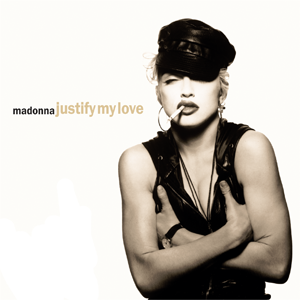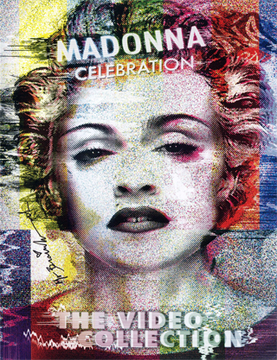
GHV2 is the second greatest hits album by American recording artist Madonna. It was released by Maverick and Warner Bros. Records on November 13, 2001, coinciding with the video album, Drowned World Tour 2001. A follow-up to The Immaculate Collection (1990), GHV2 contains a collection of singles during the second decade of Madonna's career. Madonna mentioned that she only included "songs that I could listen to five times in a row" on it. The album did not contain any new songs, but a promotional single titled "GHV2 Megamix" was released, which contained remixes by Thunderpuss, John Rocks & Mac Quayle and Tracy Young. A promotional remix album was also issued, titled GHV2 Remixed: The Best of 1991–2001.

"Justify My Love" is a song released as a single by American singer Madonna. It does not appear on any of her studio albums, but is included on her first greatest hits album, The Immaculate Collection (1990). The song was written by Lenny Kravitz and Ingrid Chavez, with additional lyrics by Madonna; Kravitz also handled the production alongside André Betts. It was released as the lead single from The Immaculate Collection on November 6, 1990, by Sire and Warner Bros. Records. Chavez was not credited on the song, which led to a lawsuit against Kravitz, eventually reaching an out-of-court settlement. Musically considered as a hip hop, dance, trip hop, and experimental pop track, it features spoken word vocals by Madonna as she releases her inner freak, touching on sexual fantasies and implying the position of a woman as the one sexually in control.

You Can Dance is the first remix album by American singer and songwriter Madonna. It was released on November 17, 1987, by Sire Records. The album contains remixes of tracks from her first three studio albums—Madonna (1983), Like a Virgin (1984) and True Blue (1986)—and a new track, "Spotlight". In the 1980s, remixing was still a new concept. The mixes on You Can Dance exhibited a number of typical mixing techniques. Instrumental passages were lengthened to increase the time for dancing and vocal phrases were repeated and subjected to multiple echoes. The album cover denoted Madonna's continuous fascination with Hispanic culture.

Erotica is the fifth studio album by American singer Madonna, released on October 20, 1992, by Maverick and Sire Records. The album was released simultaneously with Madonna's first book publication Sex, a coffee table book containing explicit photographs of the singer, and marked her first release under Maverick, her own multimedia entertainment company. For the album, the singer enlisted Shep Pettibone and André Betts, with whom she had collaborated on 1990's "Vogue" and The Immaculate Collection.

"Crazy for You" is a song recorded by American singer Madonna for the film Vision Quest (1985). It was released on March 2, 1985 by Geffen Records as the lead single from the film's soundtrack album. Film producers Jon Peters and Peter Guber, along with music director Phil Ramone, decided to use Madonna after listening to her previous recordings, employing John Bettis and Jon Lind to write the song. After reading the script of the film, Bettis and Lind wrote the song about the situation in which the lead characters meet at a nightclub. Initial recording sessions did not impress Bettis and Lind, and they felt that "Crazy for You" would be dropped from the soundtrack. However, a new version was recorded to their liking.

"Into the Groove" is a song recorded by American singer Madonna, and featured on the 1985 film Desperately Seeking Susan. Written and produced by both Madonna and Stephen Bray, the main inspiration behind the song was the dance floor; the singer wrote it while watching a Latin American man to whom she was attracted. Its instrumentation features synthesizers and drum machines, with Madonna's voice being double tracked on the chorus. Sexual innuendos and undertones are present throughout the lyrics, which are written as an invitation to dance with the singer. Originally written for her friend Mark Kamins, Madonna later decided to use it on the film, as one of the scenes needed a dance song. It was later added to the 1985 international re-issue of her second studio album, Like a Virgin (1984), and remixed for her compilations You Can Dance (1987), The Immaculate Collection (1990), and Finally Enough Love: 50 Number Ones (2022).

"Fever" is a song written by Eddie Cooley and Otis Blackwell, who used the pseudonym "John Davenport". It was originally recorded by American R&B singer Little Willie John for his debut album, Fever (1956), and released as a single in April of the same year. The song topped the Billboard R&B Best Sellers in the US and peaked at number 24 on the Billboard pop chart. It was received positively by music critics and included on several lists of the best songs when it was released.

"Live to Tell" is a song by American singer Madonna from her third studio album, True Blue (1986). The song was composed by Patrick Leonard as an instrumental for the score of Paramount's film Fire with Fire, but Paramount rejected it. Leonard then presented the track to Madonna, who decided to use it for At Close Range, a film starring her then-husband Sean Penn. Madonna wrote the lyrics, co-composed the melodies and co-produced it with Leonard. "Live to Tell" was released as True Blue's lead single in 1986, by Sire Records; afterwards, it was included on Madonna's compilation albums The Immaculate Collection (1990), Something to Remember (1995), and Celebration (2009). A pop ballad, the song includes instrumentation from guitars, keyboards, drums and a synthesizer, while the lyrics deal with deceit, mistrust and childhood scars; Madonna also recalled in an interview that she thought about her relationship with her parents while writing the lyrics.

"Open Your Heart" is a song recorded by American singer-songwriter Madonna for her third studio album True Blue (1986). Written by Gardner Cole and Peter Rafelson, it was conceived as a rock and roll song titled "Follow Your Heart" for singer Cyndi Lauper, but Cole and Rafaelson never had the chance to play it for her. At the time, Cole's management was working with Madonna's, who were looking for material for her third studio album. After her manager asked Cole to present a female demo of the song, Madonna accepted it and, alongside producer Patrick Leonard, turned it into a dance song. Lyrically, it's an innuendo-laden love song where the singer expresses her sexual desire. In the United States, the song was released as the fourth single from True Blue on November 12, 1986; overseas, it was released on December 1. Furthermore, it was included in the compilation albums, The Immaculate Collection (1990), Celebration (2009), and the "video version" was featured on the 2023 remix-themed compilation, Finally Enough Love: 50 Number Ones.

"Vogue" is a song by American singer Madonna from her soundtrack album, I'm Breathless (1990). Written and produced by herself and Shep Pettibone, it was inspired by voguing, a dance which was part of the underground gay scene in New York City. The song was released as the lead single from the album on March 20, 1990, by Sire Records and Warner Bros. Records. "Vogue" is a house song with influences of disco, which contains escapist lyrics describing the dance floor as "a place where no boundaries exist". Its middle eight features Madonna name-dropping several actors from the Golden Age of Hollywood. "Vogue" was later included on three of Madonna's compilation albums: The Immaculate Collection (1990), Celebration (2009), and Finally Enough Love: 50 Number Ones (2022).

"Rescue Me" is a song by American singer Madonna from her first greatest hits album, The Immaculate Collection (1990). Written and produced by Madonna and Shep Pettibone, the song was released as the second single from The Immaculate Collection on February 26, 1991, in the United States, and as the third single on April 7 in the United Kingdom. A dance-pop and gospel-house track, the song is accompanied by the sound of thunder and rain, with the lyrics talking of romantic love rescuing the singer.

"Erotica" is a song by American singer Madonna from her fifth studio album of the same name (1992). It was written and produced by both Madonna and Shep Pettibone, with additional writing from Anthony Shimkin. In Australia and most European countries, the song was released as the album's lead single on September 29, 1992; in the United States, it was set to be released the following day, but after being leaked and played on several radio stations, the release date was held back until October 13. The song continued Madonna's exploration of spoken word vocals, which she had introduced in "Justify My Love" (1990). A pop hip-hop and dance song with Middle Eastern influences, its lyrics talk about sadomasochism, with the singer using the alter ego Dita and inviting her lover to be submissive while she makes love to him.

"Deeper and Deeper" is a song by American singer Madonna from her fifth studio album, Erotica (1992). It was written and produced by both Madonna and Shep Pettibone, with additional writing from Anthony Shimkin. In Australia and most European countries, the song was released as the album's second single on November 17, 1992; in the United States, a release was issued on December 8. It was included on Madonna's second greatest hits compilation, GHV2 (2001). A dance-pop and deep house song, it has disco and Philadelphia soul influences; the bridge features instrumentation from flamenco guitars and castanets, and features background vocals from the singer's collaborators Donna De Lory and Niki Haris. Lyrically, the song talks about sexual desire, though it has been argued that it is actually about a young man coming to terms with his homosexuality, and includes a reference to Madonna's single "Vogue" (1990).

"Bad Girl" is a song by American singer and songwriter Madonna from her fifth studio album, Erotica (1992). It was written and produced by both Madonna and Shep Pettibone, with additional writing from Anthony Shimkin, and released by Maverick, Sire and Warner. In Australia and most European countries, the song was released as the album's third single on February 2, 1993; in the United States, a release was issued on March 11. "Bad Girl" is a pop and R&B ballad with lyrics that describe a woman trying to escape her reality through self-destructive behaviors, such as drinking and chain smoking.

"Rain" is a song by American singer Madonna from her fifth studio album, Erotica (1992), released by Maverick, Sire and Warner. Written and produced by Madonna and Shep Pettibone, in Australia and most European countries, the song was released as the album's fifth single on July 17, 1993; in the United States, a release was issued on August 5. A pop ballad that mixes elements of R&B, trip-hop, and new-age music, its lyrics liken water and rainfall to the power of love.

American singer Madonna has released 14 studio albums, three soundtrack albums, six live albums, seven compilation albums, and 39 other limited releases. Recognized as the world's best-selling female recording artist of all time by the Guinness World Records, Madonna has accumulated a total record sales of more than 300 million units worldwide, with the International Federation of the Phonographic Industry (IFPI) confirming in 2006, that Madonna's albums alone had sold over 200 million copies worldwide. She is ranked by the RIAA as the best-selling female rock artist of the 20th century and third highest-certified female artist in the United States, with 65.5 million album units. She holds the all-time record for the most number-one albums by a female artist in major music markets such as Australia, Germany, and the United Kingdom.

"This Used to Be My Playground" is a song recorded by American singer Madonna. It is the theme for the film A League of Their Own, which starred Madonna, and portrayed a fictionalized account of the real-life All-American Girls Professional Baseball League. Madonna was asked to record a song for the film's soundtrack. At that time she was busy recording her fifth studio album, Erotica, with producer Shep Pettibone. They worked on some ideas and came up with "This Used to Be My Playground" in two days. Once presented to director Penny Marshall's team, the song was released as a standalone single on June 16, 1992, by Warner Bros. Records. However, it was not available on the film's soundtrack due to contractual obligations and was later added to the Olympics-inspired Barcelona Gold compilation album, released that summer. The song was included on Madonna's 1995 ballads compilation Something to Remember.

The Immaculate Collection is the second music video compilation by American singer-songwriter Madonna. Released by Warner Music Vision, Warner Reprise Video and Sire Records on November 13, 1990, to accompany the audio release, it contained music videos for the singer's singles released between 1983 and 1990. Although it did not contain all of Madonna's music videos at that point, the collection marks the first time the clip for "Oh Father" (1989) was commercially available worldwide, as it was first limited to the United States.

Celebration: The Video Collection is a greatest videos DVD compilation by American singer-songwriter Madonna. Released by Warner Bros. Records on September 29, 2009, the release accompanied the greatest hits compilation Celebration (2009). The collection follows on from her other greatest videos compilations The Immaculate Collection (1990) and The Video Collection 93:99 (1999). The release of the DVD was announced in July 2009 and contained videos spanning Madonna's entire career from 1983 to 2009.






















